Top 10 Iconic Buildings
There are many different types of buildings all throughout the world, and occasionally a building is built that captivates a city or even a nation. Over time these buildings become the defining pinnacle of the greatness of the city they improve the skyline of. This is a list of buildings that the world wouldn’t be the same without.
10. Hagia Sophia
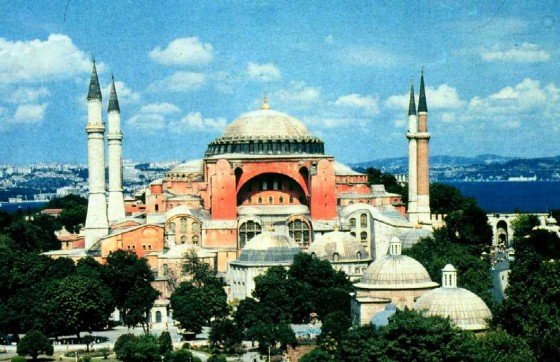
Built on the site of a 4th century church, of which nothing remains, the Hagia Sophia has been a focal point in Istanbul (formerly Constantinople) ever since. The great church is now a museum but it wasn’t always so: for centuries it served as a pillar of the Greek Orthodox Church and then as an Islamic Mosque. The second church was destroyed by a fire during the Nika Riots in 532, although remnants of it can still be seen today. The Hagia Sophia that can be seen today was built between 532 and 537 and is one of the greatest surviving examples of Byzantine architecture. The biggest draw to the ancient church is the impressive 102 foot diameter dome which reaches 182 feet into the sky. Other stunning characteristics of the Hagia Sophia are the countless mosaics, the Loge of the Empress, the Marble Door, the Sultan’s Lodge, Mahmut I’s Library and the Marble Jars.
Who built it?
The first church was built on the spot where a pagan temple had stood, by Emperor Constantine himself in 360. In 405 the second church was built by Constantine’s son, Theodosius II. The third and final Hagia Sophia was built by Justinian in 532. In 1453 Sultan Mehmet II conquered Constantinople and turned it into a mosque, and subsequent sultans have made various additions since then.
9. The Louvre
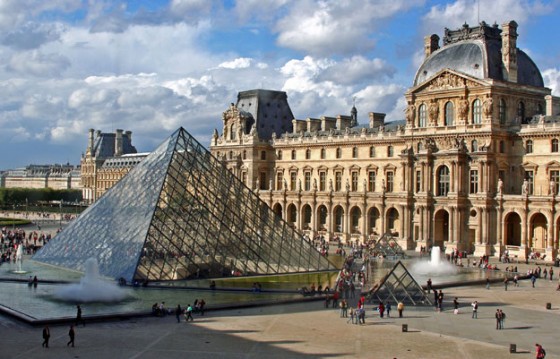
One of the most easily recognizable museums in the world, the Louvre’s Palace and the recently added glass pyramid are as beautiful to those who visit as the priceless works of art that it houses. But it wasn’t always a museum, it was originally built in the 12th century as a museum but in the 14th century it was converted into a royal residence. In 1750 Louis XV turned it back into a royal museum to house parts of the royal collection. During the French Revolution it underwent another transformation, this time from royal to public museum. Throughout the years it has been added to by Napoleon I and restored by Louis XVIII and Charles X. Today the Louvre holds 380,000 pieces; 35,000 of which are on display, including such important works as The Mona Lisa and The Venus de Milo.
Who built it?
Philip II built the Louvre Palace as a fortress somewhere between 1190 and 1202, although most of the original structure has been destroyed. The Salle Basse (Lower Hall) is all that remains of the Medieval Louvre.
8. The Burj Al Arab
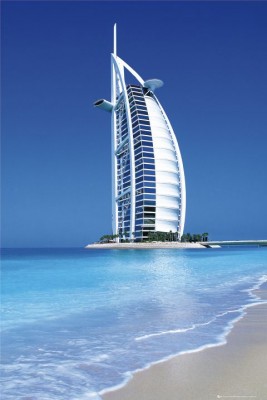
In a city famous for its architecture, the Burj Al Arab defines the Dubai skyline. The newest building on a long list of architecture built on a grand scale, the Burj Al Arab was built in 1994 and is one of the most luxurious hotels in the world. Perched on a man-made island in the Persian Gulf, it was built to mimic the sail of a dhow. The hotel features a 590-foot tall atrium, a large seawater aquarium, two restaurants (one of which was voted in the top 10 restaurants in the world by Conde Nast) and 202 luxuriously appointed suites.
Who built it?
The Burj Al Arab was designed by Tom Wright and built by Atkins for Jumeirah Hotels and Resorts. It is currently the second largest hotel in the world.
7. Sydney Opera House
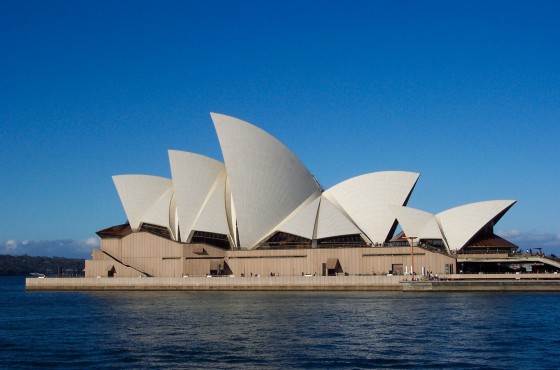
Rising out of the Sydney Harbour, the Sydney Opera House is not only the center of the arts scene in Australia but also stands out as a must see to anyone visiting the area. In the late 1940’s Eugene Goossens, the Director of the NSW State Conservatorium of Music lobbied for a new venue for large productions. In 1955 a design competition was held by NSW Premier Joseph Cahill, and by 1958 construction had begun. The winning design features several concrete shells and houses performance spaces like the concert hall, the opera theater, the drama theater, the studio, the Utzon room, the forecourt as well as a recording studio, five restaurants, four souvenir shops and a guided tour operation.
Who built it?
The winning designer was Jørn Utzon, an architect from Denmark. When Cahill insisted on radical changes to the design, Utzon resigned mid-construction and the project was finished without him. In the 90s, the Sydney Opera House Trust reconciled with Utzon, naming him a design consultant for future work but he died in November of 2008.
6. Empire State Building
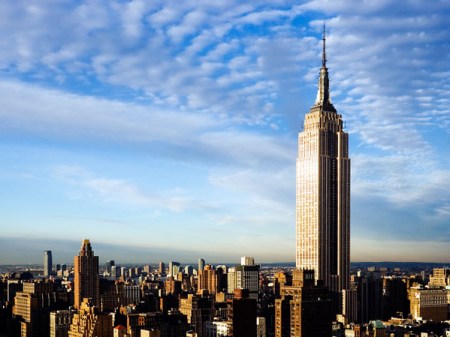
Once the tallest building in the world, no film or television show set in New York is complete without including a shot of the grand Art Deco skyscraper. Originally the site of the Waldorf-Astoria, construction of the Empire State Building began on St Patrick’s Day 1930. 410 days later construction was finished and it won the title of world’s tallest building, surpassing both 40 Wall Street and the Chrysler Building, which were being built around the same time. The opening of the building coincided with the Great Depression so it sat almost empty for the next 20 years. This wasn’t the only challenge the building has had to face: there was a 1945 plane crash, shootings in 1997, and more than 30 suicides. Through it all the Empire State Building has endured as a timeless monument of New York City.
Who built it?
The Empire State Building was designed by William F. Lamb, based on the designs for the Reynolds Building in Winston-Salem North Carolina and the Carew Tower in Cincinnati Ohio. Because of this, the staff of the Empire State Building sends a Father’s Day card to the staff of the Reynolds Building every year.
5. Taj Mahal
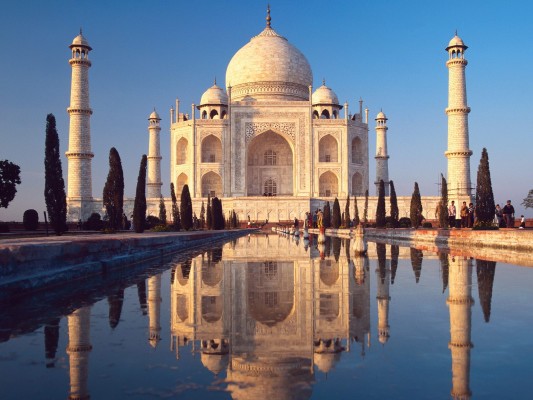
The crowning jewel of India, the Taj Mahal is a testament to one man’s love for his wife. It looks like a palace, but it was actually built as a tomb for the Emperor’s favorite wife. Construction began one year after her death in 1632 and the mausoleum was completed in 1648 with the surrounding buildings and gardens taking another five years to complete. The construction took 20,000 workers and craftsmen that were recruited from all across northern India. Soon after the Taj Mahal was completed, the Emperor was deposed by his son Aurungzeb and put under house arrest. When the Emperor died in 1658, he was buried beside his wife inside the Taj Mahal. During world War II the Indian government erected scaffolding around the Taj to mislead German and Japanese bomber pilots. Today the Taj Mahal is under a different threat: acid rain and pollution from the Mathura Oil Refinery has begun to turn its white marble yellow.
Who built it?
The Taj Mahal was built by Mughal Emperor Shah Jahan when his third wife Mumtaz Mahal died while giving birth to their fourteenth child, Gauhara Begum. He exchanged a large palace in the center of Agra with Maharajah Jai Singh for the three acres of land where the Taj now sits.
4. Eiffel Tower
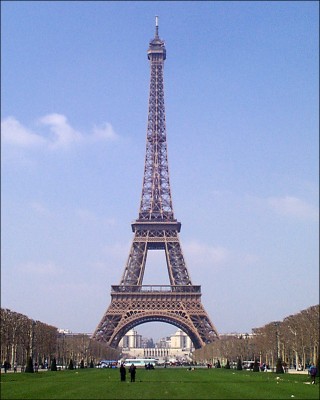
Towering high above Paris, the Eiffel Tower was built between 1887 and 1889 and acted as the entrance arch for the Exposition Universelle, which marked the centennial of the French Revolution. The tower was only supposed to stand for 20 years but it was a valuable communication tool and remained as an unmistakable element of the Paris skyline (especially as buildings in the city cannot surpass seven stories). During the German occupation of Paris during World War II, the lift cables were cut forcing German soldiers to climb the stairs to the top to hoist the swastika. Within hours of the Liberation of Paris, the lifts were back in working order.
Who built it?
The Eiffel tower was designed by engineer Gustave Eiffel who had originally submitted the design to Barcelona for the Universal Exposition in 1888 but they refused. When it was built, he engraved the names of 72 French scientists, engineers and other notable Frenchmen.
3. Big Ben
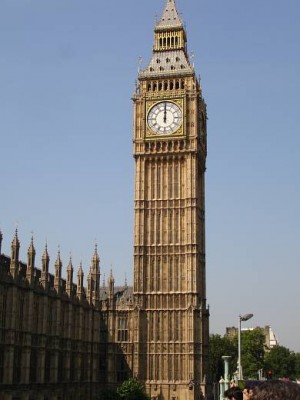
One of the world’s most famous clocks, Big Ben is actually the name of one of the bells but over the years it has come to be used for both the clock and the tower as well. It was completed during the restoration of the Palace of Westminster in 1858. The tower stands 316 feet tall, each clock face is 23 feet square with 4 foot numbers and the great bell is seven and a half feet tall and weighs 13 tons. Nobody knows exactly whom Big Ben is named after but common theories include Sir Benjamin Hall (who oversaw the installation of the bell) or English Heavyweight Boxing Champion Benjamin Count.
Who built it?
Charles Barry designed Westminster Palace, however, Augustus Pugin created the clock tower. Pugin fell into madness and died in 1852 and Big Ben was the last building he would ever design. The clock itself was designed by Beckett Denison.
2. The Colosseum
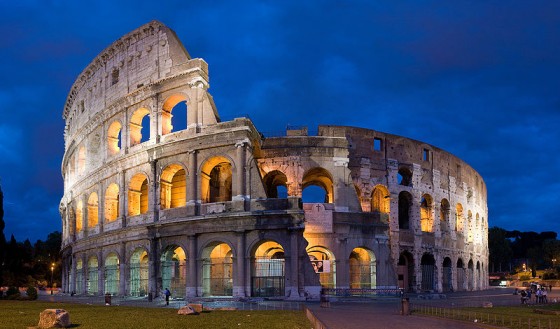
The largest Roman amphitheater ever built, the Colosseum is one of the greatest architectural feats ever achieved by the Ancient Romans. Construction began between 70 and 72 AD and was finished in 80 AD. It was capable of seating 50,000 people and was usually used for gladiatorial games, but could also be used for public spectacles, mock sea battles, animal hunts, executions, reenactments of battles, and dramas based on Classical Mythology. During the medieval era its entertainment purposes ended and it has since been used as housing, workshops, a fortress, a quarry, quarters for a religious order, and a Christian shrine. Today the Colosseum is one of the most popular tourist attractions in Rome and attracts thousands of visitors every year.
Who Built it?
The Colosseum was imagined by Emperor Vespasian who used the vast treasure seized during the Great Jewish Revolt in 70 AD to fund its construction. It was built up to the third story when Vespasian died in 79 AD, but his son Titus finished it and inaugurated it in 80 AD.
1. The Giza Pyramids
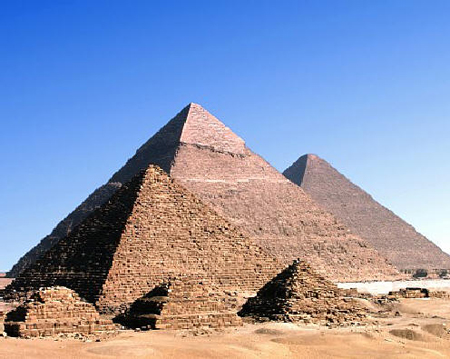
The oldest buildings on this list, the pyramids on the Giza plateau have intrigued mankind for centuries. Not only have they stood the test of time, but the accuracy with which they were built is impressive even by today’s standards. They were built as tombs for three separate pharaohs during the Third and Fourth Dynasty. It is also the only surviving wonder of the ancient world and was the tallest building in the world until 1300 when it was surpassed by the Lincoln Cathedral. Despite their long history, or perhaps because of it, mysteries have swirled around the pyramids since they were found by the Ancient Greeks thousands of years ago. How were they built? How many people worked on the project? How long did the construction take? What was the Egyptians’ understanding of astronomy, mathematics, and geography? And even crazy questions like: did aliens help in their construction? While these questions go unanswered, all we are left to do is marvel at a culture who were master builders even before the invention of the wheel.
Who built it?
The oldest and largest of the three pyramids was built by Khufu between 2551 and 2531 BC. The second was built by Khufu’s grandson Khafre between 2558 and 2532 BC. And the third pyramid belongs to Khafre’s son Menkaure and despite not knowing the exact date of the construction many believe that it was finished somewhere around 2490 BC, several years after his death.
Top 10 Weird Pageants
Here is some good news for those of us who have prepared a secret acceptance speech for that sudden moment of fame. It’s time to take it out because we don’t need to win a beauty pageant to read it aloud. We now have scores of other pageants to choose from. There is just one tiny glitch; we have to think a bit out of the box. Think about landing up in prison, being pregnant or becoming a nun. Ladies and gentlemen, please put your hands together for our top ten weird pageants ideas from around the globe.
10. Miss Atom
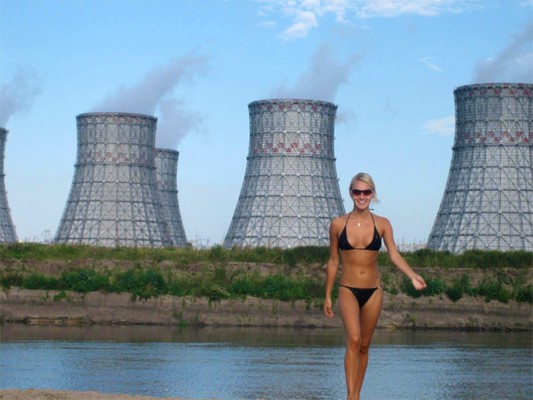
No, Miss Atom is not the name of the villain in latest Batman flick. This is a beauty pageant with a nuclear twist.
“The idea behind the contest is to demonstrate how many beautiful girls and young women work in nuclear, because this industry has been closed from public for a long time and the word “atom” evoked usually negative feelings,” explains Ilya Platonov, Nuclear.Ru’s General Manager. Nuclear.Ru is the organizer of the Miss Atom, a web-based beauty pageant open to contestants, aged 18-35, that are employees of businesses, companies and institutions of the State Corporation “Rosatom” as students of nuclear-related educational establishments.
The popular Miss Atom has been run since 2004. Apparently, last year was as hot as a fission core with a record 340 participants representing more than 60 organizations, businesses and educational institutions in nuclear related fields in Russia, Ukraine and Kazakhstan.
Profile photos often have contestants posing against backdrops like nuclear power plant, machinery and objects. Miss Atom is held every year as an image-building PR campaign for the Russian nuclear industry.
9. Miss Plastic Surgery

What can you expect in a nation obsessed with beauty pageants and plastic surgery? The first Miss Plastic Surgery was held at Beijing, China in 2004. Women and transsexuals between the age group of 17 to 62 participated in this pageant for the title of “best artificial body”. All the contestants had to present a doctor-certified proof of their surgical enhancements. Titles like Miss Biggest Change were also presented. A few shots of Botox, cheek and waist liposuction and a surgery to widen the eyes; fetched Feng Qian the title of Miss Plastic Surgery 2004.
8. Sister Italia

This was the brainchild of Father Antonio Rungi, an Italian Catholic priest. Father Rungi announced an online Sister Italia contest in 2008 for nuns in the age group of 18 and 40. People could choose the most attractive nun from the pictures and spiritual profiles in his blog. But before the contest took off, there was a huge controversy and Father Rungi had to cancel the event.
7. Alternative Miss Ireland
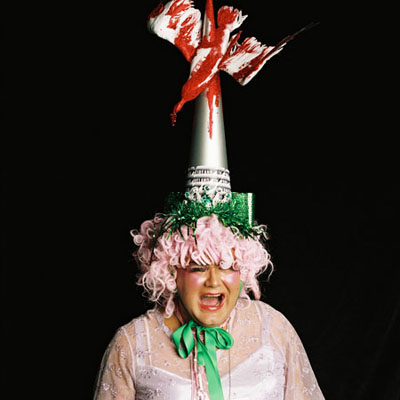
Dr. Jekyll and Hyde would have won this competition hands down. The contestants (men, women or animals) of Alternative Miss Ireland are supposed to bring out their alter egos on the stage with whatever props they consider necessary. There are swimwear and eveningwear rounds where judges looks for usual pageant stuff like poise and personality. But what happens inside these rounds can be unpredictable, whacky and outrageous. The contestants of 2009 lied down on bed of nails, turned into green monsters, cracked sex jokes and even snorted cocaine. The winner was crowned with the famous Medusa Crown of Shamrocks. http://www.alternativemissireland.com
6. Miss Pregnant

Beauty pageant candidates expelled for their hidden belly secrets can still win the crown; they just have to head in a different direction. Miss Pregnant pageants are being “born” in almost every country. After Peru and Russia, the US also had a contest for to-be-mommies in Cincinnati. The candidates had to strut down the ramp in bikinis before the judges to win $1000 for baby expenses.
5. Miss Prisoner
If looks could kill, some inmates of Bogota’s Buen Pastor Prison would be serving a double sentence. Every year this Colombian jail holds a Miss Prisoner contest in memory of Virgin of Mercedes, prisoners’ patron saint. Participants walk down in elaborate masks, feathers and gowns to win the coveted title. Contests like these are also held in Rio de Janeiro, Sao Paulo, Nairobi and Lithuania to boost confidence and desire for reform among the inmates. While cash prizes are common in these pageants, a Siberian prison even offers an early parole to the winner.
4. Miss Condom
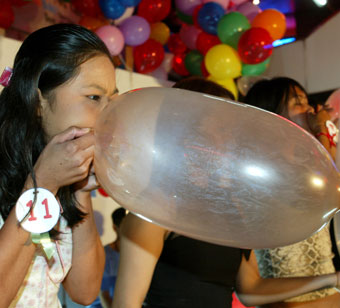
Here is how this one goes. You just take a condom, prepare your lungs and blow it to the hilt. Thailand, a country battling growing AIDS problem, hosts this four-nation contest. Aimed as an infotainment event, the contest also requires participants to answer questions on the deadly virus and safe sex practices.
3. Miss Mama Kilo

Most of the beauty pageants set a weight limit for the participants. Miss Mama Kilo also has a strict weight limit but the contestants have to be over that limit and not under it in order to qualify for the contest. The annual pageant held in Cameroon invites all women over 90 kilos to walk down the ramp. The beauties are judged not by their waist but by their views on various social issues and traditional housekeeping skills. Miss Mama Kilo is Cameroon’s way of changing perception of plus-size women.
2. Miss Muslim Moral
When Khadra al-Mubarak said he was looking for women with inner beauty to participate in his beauty pageant, he actually meant it. The participants of “Queen of Beautiful Morals” held in Saudi Arabia have to be covered completely in their black abayas. There is no Miss Congeniality, Miss Perfect Ten or Miss Beautiful Smile in this contest. Candidates are judged on their moral, family and social values. The winner of the pageant took away $1333 cash, a diamond watch and a paid vacation in Malaysia among other prizes.
1. Miss Landmine Survivor
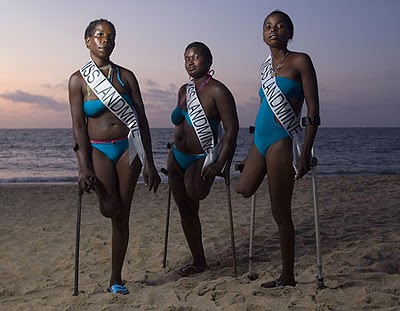
The landmine problem in Angola and Cambodia stirred artist Mortan Traavik to start this pageant. The idea was to highlight the issue and restore self-esteem among landmine survivors. The Cambodian authorities thought the contest was distasteful and banned it. It was later held in Norway. The winner of Miss Landmine Survivor Angola gets a customized prosthesis made in Norway.
Top 10 Weird Theme Parks
While you’ve heard of a few very common theme parks, below is a list of 10 theme parks that cross the line from fun to bizarre. Though Disneyland may be deemed the “happiest place on Earth,” these theme parks definitely don’t fit that mold. Some are just plain weird while others are more laughable than they are serious.
10. Diggerland
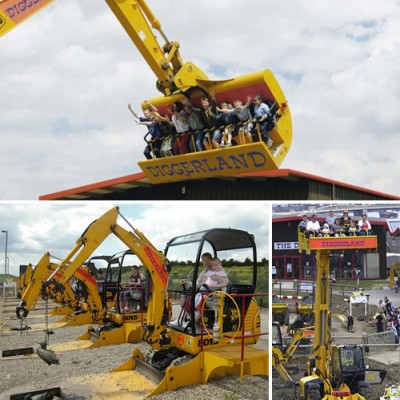
Have you ever been driving and seen a Bobcat or Caterpillar roving over dirt and grass, probably carrying gravel, and wondered what it would be like to be the driver? Well, with Diggerland, you can make that dream come true, but only if you live in England or plan to travel there. The theme park, located in four locations throughout England, is all about adventure…using construction machines and vehicles. The park opened in April 2000 and provides 19 different kid-friendly rides. All of the rides are made with real construction machines such as dump trucks, diggers, and cranes, all of which are owned by JCBs, the Bobcat of the UK. The best part about it? You can see these machines “dance.” At the park, this show is known as the “Dancing Diggers.” So if you like to get dirty and in touch with your masculine side, this park is for you. Put on your hardhat!
9. Shijingshan Amusement Park
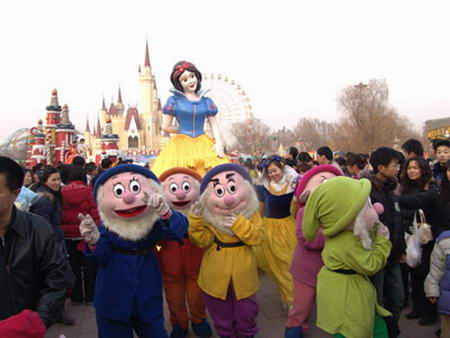
If you’re alive and breathing, you probably know something about Disneyland and the plethora of characters you will find there. While Disneyland theme parks have expanded across the globe into several locations such as France and Hong Kong, you may just come across an eerily similar park in Beijing, known as Shijingshan Amusement Park. Just by looking at the park, you can see the similarities between the two castles, but the characters you will find inside look like they’ve been transplanted from Orlando to Beijing. From Cinderella look-alikes to a “cat with large ears” that resembles Minnie Mouse, you’ll definitely start to think that the park owners may have stolen Disney and other characters. However, the park maintains that all of their characters are based on those found in Grimm’s Fairy Tales and are no way associated with Disney or other cartoon characters. However, I think the park’s slogan “Disneyland is too far” proves it all
8. Alien Apex Resort
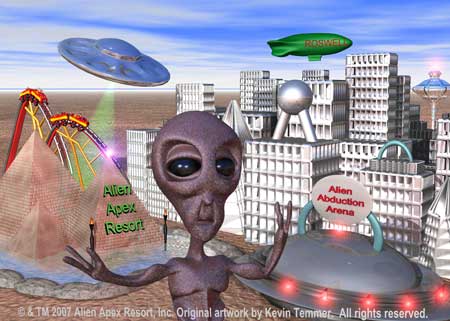
There’s nothing wrong with people dressing up as Disney or cartoon characters, or even those dressed up as your favorite chocolate bar at Hershey Park, but if you ever visit Alien Apex Resort, you’ll encounter nothing but aliens. Located in Roswell, New Mexico, a location known for a possible UFO crash, the Alien Apex Resort focuses on bringing humans into a world controlled by aliens. Though still under construction but said to open in 2010, you’ll find the most prized ride, one that takes you through an alien abduction. You’ll also find an exhibit hall with information all about extra-terrestrial life, as well as a show called “The Symbiosis,” which recreates the 1947 Roswell UFO incident using music, fireworks, and special effects. If you’re one of those alien crazed people who seemingly spot a UFO every other day, this theme park is definitely for you.
7. World Chocolate Wonderland
No, this isn’t another Hershey Park away from home; the World Chocolate Wonderland is located in China and is the first of its kind. The park opened on January 29, 2010 and is centered on everything chocolate, in fact, 176,000 pounds of chocolate. From the Great Wall of China to very famous Terracotta Warriors, you’ll find several different objects and figures made of nothing but this yummy treat, including a BMW, clothing, and even shoes. All of the exhibits are encased in glass in order to prevent melting, and probably to prevent some sweet-toothed visitor from taking a bite. The park owners created the park with the idea that due to the tough economic times in China recently, the population needed something sweet. You’ll also be able to enjoy a fashion show at the park with models wearing nothing but clothing crafted using chocolate. How’s that for every man or woman’s dream? Visit Site
6. Haw Par Villa
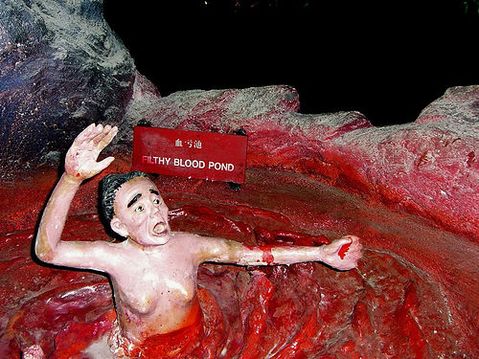
Located in Singapore, the Haw Par Villa is a theme park based around folklores from Chinese literature. The villa, the oldest on the list, was built in 1937 and was first known as Tiger Balm Gardens and was eventually renamed in 1985 when it was sold to new owners. While once considered an amusement park, Haw Par was revamped and the well-known dragon rollercoaster was removed. Because the park is centered on Chinese folklore, you will find many statues, 1000 to be exact, dedicated to certain stories, many of them relating to Confuscianism. At the park there are also about 150 dioramas that depict several different scenes. While the park seems to have nothing bizarre about it, once you get a look at some of the statues, you definitely understand. You’ll find dioramas entitled “Filthy Blood Pond” as well as a scene of blue demons dismembering a chained prisoner. You’ll also find the “Ten Courts of Hell” which depict grotesque sights of the many punishments for sinners.
5. Holy Land Experience
While there’s nothing wrong with religion, there is definitely something odd about a theme park based around life during the time of Jesus, the odd part being that the park does reenactments of many events, including the crucifixion of Jesus. If you’re a devout Christian, this park just may take you to Heaven in Orlando, Florida. The park was built in order to allow present-day people to experience life during ancient times in the Holy Land. At the park you’ll find a town made to look like olden-day Jerusalem with markets, a Judean Village, a Temple, and even a Garden Tomb that is meant to look like the one Jesus was buried in, as well as many other structures that were built to present the architecture and life 2000 years back. There are also old artifacts that allow every visitor to picture themselves in the life of someone living in the Holy Land. While this park is very spiritual and educational, it doesn’t fit the perfect mold for a theme park.
4. Memory Village
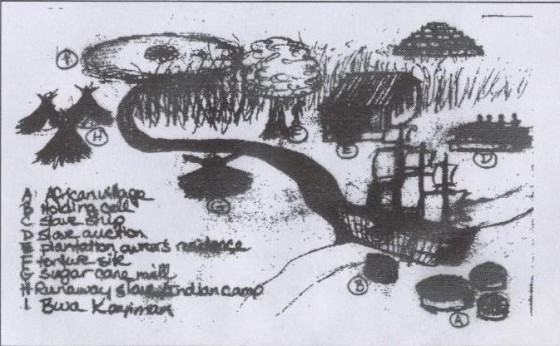
Another theme park that takes its visitors back into time, Memory Village is one that provides everyone the chance to experience life as a slave. Though not an established theme park, Ron and Carla Bluntschli of Haiti want to create the first theme park revolving around slaves in hopes of educating the public about slavery. Those who visit the park are given the chance to be a participator or a spectator. Those who decide to take on the participating role are given traditional slave clothing and are then mock-kidnapped, chained, and forced to load a mock slave ship. Other participators are “sold” and put on a plantation. After the end of the 12 hour day, participants reenact a slave rebellion and free themselves. Even though the park is still in the works, it definitely deserves a spot on the list as the idea of a slave-theme park is entirely bizarre. Visit site
3. Grutas Park
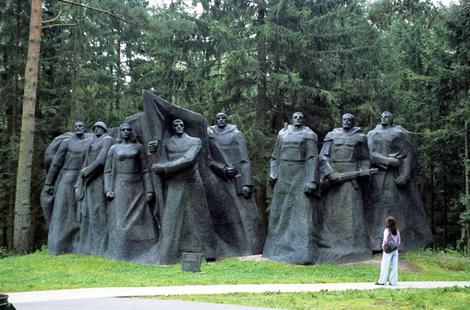
Keeping on with the topic of human oppression, Grutas Park is another theme park that really twitches a nerve in your head. Sometimes known as “Stalin’s World” and “the park of totalitarianism,” Grutas Park is located in Lithuania and is definitely no Disneyland. The park is surrounded by barbed wire as well as watch towers; not the happiest of sights. Founded by Vilumas Malinauskas, the park is home to statues of extremely famous Soviets, including Lenin, Marx, Dzerzhinsky, and even Stalin, just to name a few of the 100 statues found there. These statues were placed in the park after they were dismantled in 1990 after Lithuania gained its independence. To bring in a sense of light-heartedness and child-friendliness, the park added a zoo filled with peacocks and ostriches as well as plenty of other animals. Somehow, my brain can’t put together a peacock and Stalin at the same place. Visit site
2. Bon Bon Land

If any park on this list screams “wrong,” this theme park is definitely it. The park was built in 1998 and has since undergone construction in order to add new rides and attractions. Located in Denmark, this park focuses on scatological ideas and humor…that’s right, poop. While it features plenty of cute farm-animal characters that all children would love to look at, the obscene gestures that they are making turn the park into one big disturbing place. From afar it seems quite innocent, but with a roller coaster named “Dog Fart Coaster” and figures of naked pigs with their human-esque breasts showing, it’s anything but. However, somehow, the park is deemed to be very family friendly and offers all types of fun and events, from shows, to rollercoasters, rafting, and even playgrounds.
1. Love Land
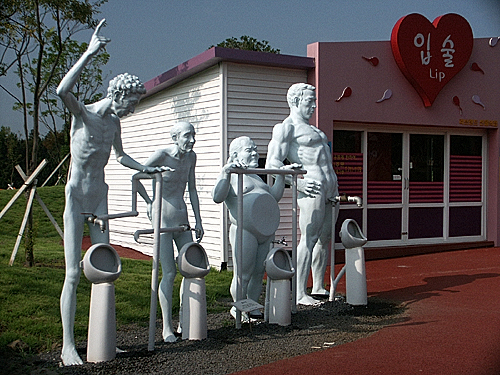
Love Land definitely deserves the top spot on the list. Now, if you thought Freud overdid it when it came to phallic, vaginal, or sexual symbols, you’ve seen nothing until now; meet Love Land. Located in Cheju Island in South Korea, the park is literally based around nothing but sex, and was meant to be for adults-only, but was eventually demolished before it was even able to open to the public. The whole idea behind the park was to help Chinese citizens “enjoy a harmonious sex life.” At the park you’d have found giant statues of penises, vaginas, and statues committing a several different sexual acts. While the park was actually built and prepared to open in October 2009, the Chinese government deemed the theme park to be overtly sexual and considered it to be a very negative influence on the Chinese culture.
Top 10 Gourmet Cities
To some travelers, the food is just as important as anything else a destination has to offer. For these foodies, only the best will do, so this is a list of destinations that will satisfy the appetite of any traveler.
10. Singapore (Singapore)

Borrowing from Chinese, Indian, Malaysian, Tamil and Peranakan cuisines, the food in Singapore is as multi-cultural and unique as the island (and microstate) itself. For a truly unique dining experience, take in one of the city’s hawker centers: open-air food complexes filled with stalls serving all kinds of inexpensive delights. Some of the more popular ones are the Adam Road Food Center, Chomp Chomp Food Center, Lau Pa Sat Food Center, Newton Circus Food Center and Zion Road Riverview Food Center. Singaporeans are passionate about their cuisine. Some local specialties are: Satay, Roti Prata, Char Kway Teow (sweet and savory noodles), Chili Crab, Hainanese Chicken Rice, Fried Carrot Cake, Rojak and Barbequed Stingray (served on a banana leaf).
When it comes to fine dining, Singapore offers gourmet fare from across the globe. Some of the best restaurants to choose from: The Song of India, il Lido, Graze, Mango Tree Restaurant, Blue Ginger, Oso Ristorante, Hai Tien Lo, Ghorkha Grill, IndoChine Waterfront, Café Samar, Original Sinand Morton’s The Steakhouse.
What Else To Do?
Between meals why not check out the Singapore Flyer, Chinatown, the Botanic Gardens or take a shopping trip down Haji Lane, Singapore’s premier shopping district.
9. Honolulu (U.S.A.)
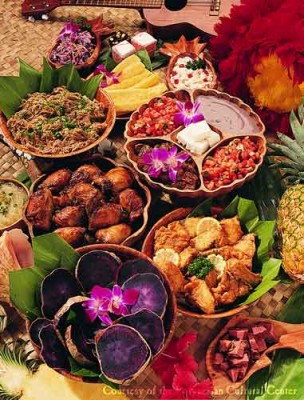
When one thinks of Hawaii, images of a tropical island paradise instantly come to mind, but one of the real treats here is the food. Hawaiian cuisine is a unique mix of dishes from Asia and many different Pacific island cultures. Some local favorites are Lau Lau (pork chicken or vegetables steamed in a pouch of ti leaves), Lomi Salmon, Butterfish, Poke (a raw ahi tuna salad) and Poi (a dish made with mashed taro). But the crowned jewel of Hawaiian cuisine is Kalua Pork, cooked in an underground oven called an imu all day long, it is usually the centerpiece of any luau. One great way to take in the gastronomical delights of the city is to take in a restaurant tour by Hawaii Food Tours (created by former executive chef and food critic Matthew Gray). If you prefer dining in a single restaurant try La Mer, Alan Wong’s, Roys, Hoku’s, Chef Mavro, Hy’s Steakhouse, Orchid’s or 3660 on the Rise.
What Else To Do?
As with any island, checking out the beach is usually close to the top of any traveler’s list, especially when you are so close to one of the most famous beaches in the world, Waikiki Beach. Another must see, especially for history buffs, is the Visitor’s Center and the Arizona Memorial at Pearl Harbor.
8. Fes (Morocco)
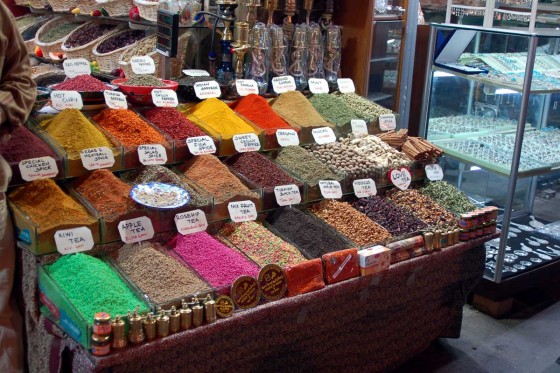
Spices have been imported to Morocco for thousands of years and this tradition is still evident in Moroccan cuisine today, along with cultural influences from Berber, Moorish, Mediterranean, Arab and African cultures. Unlike other cultures, the mid day meal is the Moroccan’s main meal of the day (except during Ramadan). Some of the staples are couscous, beef, lamb, poultry, sheep, and locally grown fruits and vegetables. These are heavily featured in dishes like Pastilla (a meat pie made with squab or chicken), Tagine (slow cooked lamb or chicken with vegetables and spices), Harira (a thick soup of tomatoes, lentils, chickpeas and meat served on special occasions) and of course Kebabs. The restaurants in Fes not only serve exceptional Moroccan food but also embrace cuisine from around the world. Some of the best are Al Fassia, L’Ambra, La Kasbah Restaurant, Medina Café, Palais de Fes, Le Majestic, Vesuvio and Jnan Palace. Of course the best way to taste Moroccan cuisine is to be lucky enough to be invited into someone’s home as Moroccans rarely eat Moroccan food at a restaurant. Photo: moroccanhospitality.com.
What Else To Do?
Fes is a beautiful city with a rich history. Some of its best sights are Bou Inania Madersa, the Merenid Tombs, the Berber Pharmacy and the Tannery in the Medina, as well as the exquisitely decorated exteriors of the Moulay Idriss Il shrine, Qaraouvine Library and Mosque and the al-Tijani Mosque (only Muslims are permitted to enter because they are all working Mosques).
7. Sicily (Italy)
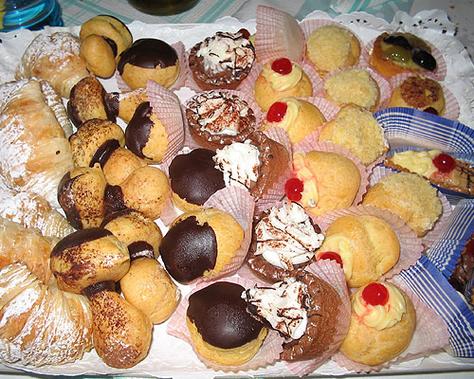
As with most island cultures, fish and seafood is king and in Sicily they are prepared with fresh vegetables grown in the fertile soil in the shadow of Mount Etna. The simply prepared dishes traditionally served here are evidence of occupation by Greeks, Romans, Arabs, Normans and other European cultures, however, the Arabian influence seems to be the strongest. The Sicilians have a penchant for freshness and as such you will rarely eat anything that wasn’t produced within a few miles of where you are eating. Some traditional Sicilian dishes include Caponeta (a salad of eggplant, olives, capers and celery), Pizza, Crocche (fried potato dumplings), Arancine (fried rice balls), Grilled Swordfish, Snapper, Cuttlefish and Veal Marsala. Sicilians are also renowned for their sweets including Cannoli, Cassata, Frutta di Martorana (almond and marzipan pastries), Gelato and Granita, as well it is possible that ice cream was invented here. All of this is paired with red, white and dessert wines that have emerged on the world stage within the past few years. Some of the best restaurants here are Il Ristorantino, Osteria del Doumo, Casa Grungo, Il Barocco, Locanda don Serafino, Ristorante Il Dehor, Bye Bye Blues, La Grotta di Carmelo and Don Camillo.
What Else To Do?
Some of the must sees on this beautiful Mediterranean island include Mt. Etna, the medieval cliff side town of Taormina, the Valley of the Temples, the Museo Archeologico, San Cataldo ( a 12th century Norman church) or taking in an opera or a concert at Teatro Massimo.
6. Bangkok (Thailand)
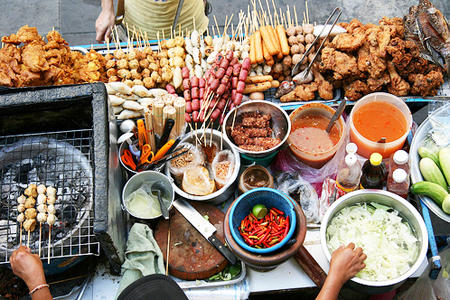
Any true foodie has at least tried Thai food once, and the best Thai cuisine in the world can be found in the bustling metropolis of Bangkok. The Thai capital offers a multitude of dining options from street vendors to five star restaurants (usually found in upscale hotels) and offering not only great Thai food but also Japanese, Chinese, Indian, Korean, German, British and Italian food however the Western restaurants are generally more expensive. Here you can have dishes like Pad Thai, Tom Yum Goong, Satay, Kanom Roti, Chu Chi Pla (spicy papaya salad) and Som Tam Thai (deep-fried chicken wings). Some of the best food to be found in Bangkok is sold by street vendors, but use common sense and when in doubt follow the locals. For those who are less adventurous, some of the best restaurants in town are Sala Rin Naam at The Oriental Bangkok, Lemongrass, Spice Market at The Four Seasons, Gianni Ristorante, Maha Naga, Baan Khanitha, Harmonique, D’Sens at the Dusit Thani and Sirocco.
What Else To Do?
Bangkok is Thailand’s tourist gateway and one of the world’s major tourism hot spots, and any of these visitors would tell you that no trip to the city would be complete without a visit to The Grand Palace, Wat Pho, Wat Arun, The Klongs, Muang Boran, Wat Sutat, Bangkok National Museum, The Royal Elephant Museum and Vimanek Mansion.
5. Napa Valley (U.S.A.)
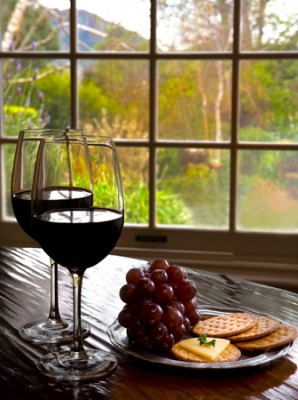
Napa Valley, California is a perfect example of how great food follows great wine. Here simple light dishes are prepared with fresh ingredients bought in Farmer’s Markets that morning or grown at the restaurant itself. Also, here fusion cuisine takes on a persona of its own with Pan-Pacific cuisine blended with locally grown ingredients. It is due to this affinity for freshness that menus change with the seasons and sometimes even daily. Food in the Napa Valley is almost always prepared to complement the fine selection of local wines. Napa cuisine is not only influenced by Spain and Mexico but also by the Italians that established the wine industry in the region. And as a result, the Napa Valley has been transformed into a Neo-Tuscan wonderland. Probably the best restaurant in the area (and many would consider it the best in the United States) is Yountville’s French Laundry. Other great restaurants include Cucina Italiana, Neela’s, La Toque, Redd, Café La Haye, Bistro Jeanty, Bouchon and etoile at Domaine Chandon.
What Else To Do?
Wine is the center of Napa Valley tourism and a visit to a winery is a must. Other attractions in the area include Lake Hennessey, Safari West, Alla Prima Studio, one of the local Farmer’s Markets, the Napa Valley Opera House, Charles M. Shultz Museum and the Petrified Forest.
4. London (England)

London is a multicultural metropolis with a vibrancy and a personality all its own. Because of this, you can find a multitude of different cuisines here from around the world as well as traditional British fare. Originally, British cuisine was defined by simple dishes made with local ingredients, however, it has continually evolved, first with British colonization and then with those who have settled in Britain from around the world. Some British dishes include fish and chips, steak and kidney pie, shepherds pie, bangers and mash, Sunday roast, Cheshire cheese, Yorkshire pudding, and trifle. But you will also find food from India, China, Africa, the Middle East, Vietnam, Greece, Turkey, France, Italy, just to name a few. Some of the best dining experiences to be found are Gordon Ramsay at 68 Royal City Avenue, Petrus, The Gun, Pasha, BoxWood, Clos Maggiore, The Ivy, Melati, Notting Grill, Marcus Wareing at the Savoy Grill, Stef’s, Terra and Christopher’s American Grill.
What Else To Do?
London’s extensive history has left a plethora of must see buildings like the Buckingham Palace, Tower of London, the Tower Bridge, St. Paul’s Cathedral, Windsor Castle, Hempton Court Palace, Kensington Palace or Shakespeare’s Globe Theater. Also, check out newer attractions like the London Zoo, Thames River Cruise, the London Eye or taking in a play or musical in London’s famous West End.
3. New York City (U.S.A.)

To many, New York City is the center of the universe and it’s undeniable ability to attract immigrants searching for the American dream is world renowned. Over the years, these immigrants brought their food and culture with them and the city itself has created signature dishes like Manhattan Clam Chowder, the New York Bagel, the New York Hot Dog, the New York Deli Sandwich, New York style pizza, New York Cheesecake, New York Egg Cream and the Waldorf Salad. New York offers everything from street food to five star dining and cuisines from every corner of the globe. From Little Italy to Chinatown to the Kosher Lower East Side and everything in between; the only problem you will have in New York is deciding where to eat first. Some of the lower-priced establishments have become monuments in their own right, like The Carnegie Deli, Lombardi’s (the first pizzeria in America), Katz’s Deli, Nathan’s, Ray’s Pizza, Junior’s, Gray’s Papaya and Lindy’s. For fine dining some of the best choices are: Nobu, Daniel, Le Bernardin, Per Se, Café Boulud, Gramercy Tavern, Peter Luger Steakhouse, Bouley, Jean Geroges, Masa, Babbo Ristorante e Enoteca, Aureole and Le Cirque. Photo: delinyc.com.
What Else To Do?
New York is a tourist’s dream with an iconic attraction around every turn, but the best of the best are the Empire State Building, Times Square, the Statue of Liberty, Grand Central Station, Rockefeller Center, Ellis Island Immigration Museum, the Staten Island Ferry, Central Park, the Metropolitan Museum of Art and the Ground Zero Museum. After a day of sightseeing, take in a musical or play in one of the world renowned Broadway Theaters.
2. Paris (France)

The French’s passion for food is well known across the globe and it’s this devotion to their gastronomy that makes French cuisine one of the best in the world. In France each region has its own traditional dishes depending on what is grown locally but as trains from these areas all converge on Paris, it is the perfect place to taste the best of what France has to offer. The best of French cuisine ranges from the over the top elegance of Haute Cuisine to the understated simplicity of Cuisine Nouvelle, with a lot of options in between. The food here has evolved from the Middle Ages and heavily features cheese, wine, bread, cream, mushrooms, goose, chicken, beef, veal, sardines, oysters, shrimp, calamari and fresh produce all seasoned with a variety of herbs. Some of the most well known French delights include crepes, baguettes, coq au vin, cassoulet, quiche Lorraine, bouillabaisse, fondue, ratatouille, croissants and other pastries, as well as delicacies like fois gras, escargot, frog’s legs and caviar. Eating establishments in Paris range from bistros and cafes to five star restaurants that are featured in the Michelin Guidebook. Some of the best restaurants Paris has to offer are La Tour d’Argent, Le Grande Cascade, Le Meurice, Taillevent, Music Hall Restaurant, Pomze, Pierre Gagnaire, Plaza Athenee, Citrus Etoile, Le Grand Vefour, L’Ambroisie, Aperge, Pavillion LeDoyen, L’Astrance, Pre Castelan and Guy Savoy.
What Else To Do?
One of the most romantic cities in the world, Paris has a plethora of must see sights including the Eiffel Tower, the Louvre, Notre Dame Cathedral, The Arc de Triomphe, a river cruise on the Seine, Napoleon’s Tomb at Les Invalide, the Musee d’Orsay and the Opera Garnier.
1. San Sebastian (Spain)

Nestled in the heart of Spanish Basque country, San Sebastian (or Donostia to the locals) has more Michelin stars per person that any other European city, making it practically impossible to eat badly while you’re there. Sandwiched between the sea on one side and the fertile Ebro Valley on the other, San Sebastian’s cuisine incorporates the very best of both sides. Not unlike the rest of Spain, San Sebastian is filled with pintxo bars (called tapas bars elsewhere) serving small portions of many different dishes until around 7pm, after which the Spanish dinnertime starts. Some of the typical dishes you will find here are Marmitako (tuna stew), Bacalao a la Vasca (salt cod with tomatoes), Txangurro (hot spider crab), Percebes (goose neck barnacles), Talos (tortillas), wood pigeon, pisto (similar to Ratatouille), Txipirones (baby squid in its ink) and grilled and roasted meats. Some of the best places to eat here are Arzak (the first Michelin 3 star restaurant in Spain), Alona Berri, Extebarri, Martin Berasategui, Akelarre, Mugaritz, Fagollaga, Miramon Arbelaitz, Urepel, Casa Nicholasa, Rekondo, Kursal, La Muralla, Lanziego, Kaskazuri Restaurant ans Branka, although almost every restaurant and pintxo bar in town promises an exceptional dining experience.
What Else To Do?
San Sebastian is a coastal town where the best thing to do is lay on the beach and wait for the next scrumptious meal. It’s the kind of place where the chaos of your regular life drifts away into the beauty of the city. For those who are more adventurous, go for a climb up Monte Urgull or Monte Igueldo, visit the Naval Museum or the Museo de San Telmo or take a stroll through the Parte Vieja, the historic area of the city(it is also the area to find the best pintxos).